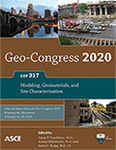Geo-Congress 2020
Stability Analysis of Jointed Rock Slope Using Finite Element Method (FEM) with the Random-Joints Generation Model
Publication: Geo-Congress 2020: Modeling, Geomaterials, and Site Characterization (GSP 317)
ABSTRACT
In this study, the stability of jointed rock slope was evaluated using the finite element method (FEM) with the random-joints generation 2D model. The in-house model to simulate joints randomly generated in the rock was developed based on the Monte Carlo method and a normal probability distribution that can be obtained in the field investigation. The model was employed into COMSOL Multiphysics through a subroutine program written by MATLAB. As for the mechanical parameters of joints, the S-type weakening curve equation was used so that each joint has individual mechanical parameters. Compared to a conventional model to simulate the joints, the developed model can simulate the physical characteristics of the jointed rock slope, which reflects the control function of joints in the stability of the rock slope closed to the field. To validate the model, the failure case of jointed rock slope in the field was compared to one predicted by this random joint model. The results were in good agreement with deformation characteristics of the slope observed in the field.
Get full access to this article
View all available purchase options and get full access to this chapter.
REFERENCES
Cundall, P. A., Strack, O. D. (1979). “A discrete numerical model for granular assemblies.” Geotechnique, 29(1), 47-65.
Fredlund, D. G., and Krahn, J. (1977). “Comparison of slope stability methods of analysis.” Canadian geotechnical journal, 14(3), 429-439.
Goodman, R. E., Taylor, R. L., and Brekke, T. L. (1968). “A model for the mechanics of jointed rock.” Journal of Soil Mechanics & Foundations Div, 94, 287-332.
Govender, N., Wilke, D. N., and Kok, S. (2015). “Collision detection of convex polyhedra on the NVIDIA GPU architecture for the discrete element method.” Applied Mathematics and Computation, 267, 810-829.
Hammah, R. E., Yacoub, T. E., Corkum, B., Wibowo, F., and Curran, J. H. (2007). “Analysis of blocky rock slopes with finite element shear strength reduction analysis.” In Proceedings of the 1st Canada-US Rock Mechanics Symposium (pp. 329-334).
He, L., Tian, Q., Zhao, Z., Zhao, X., Zhang, Q., and Zhao, J. (2018). “Rock slope stability and stabilization analysis using the coupled DDA and FEM method: NDDA approach.” International Journal of Geomechanics, 18(6), 04018044.
Jing, L. (2003). “A review of techniques, advances and outstanding issues in numerical modelling for rock mechanics and rock engineering.” International Journal of Rock Mechanics and Mining Sciences, 40(3), 283-353.
Louis, C. (1972). Rock hydraulics. In Rock mechanics (pp. 299-387). Springer, Vienna.
Qin, S. Q., Jiao, J. J., and Li, Z. G. (2006). “Nonlinear evolutionary mechanisms of instability of plane-shear slope: catastrophe, bifurcation, chaos and physical prediction.” Rock Mechanics and Rock Engineering, 39(1), 59-76.
Qin, S., Jiao, J. J., Wang, S., and Long, H. (2001). “A nonlinear catastrophe model of instability of planar-slip slope and chaotic dynamical mechanisms of its evolutionary process.” International Journal of Solids and Structures, 38(44-45), 8093-8109.
Sarma, S. K. (1979). “Stability analysis of embankments and slopes.” Journal of Geotechnical and Geoenvironmental Engineering, 105(ASCE 15068).
Shi, G. H. (1992). “Discontinuous deformation analysis: a new numerical model for the statics and dynamics of deformable block structures.” Engineering computations, 9(2), 157-168.
Sitharam, T. G., and Latha, G. M. (2002). “Simulation of excavations in jointed rock masses using a practical equivalent continuum approach.” International Journal of Rock Mechanics and Mining Sciences, 39(4), 517-525.
Snow, D. T. (1968). “Rock fracture spacings, openings, and porosities.” Journal of Soil Mechanics & Foundations Div, 94(1):73–92.
Stead, D., Eberhardt, E., and Coggan, J. S. (2006). “Developments in the characterization of complex rock slope deformation and failure using numerical modelling techniques.” Engineering geology, 83(1-3), 217-235.
Unlu, T., Akcin, H., and Yilmaz, O. (2013). “An integrated approach for the prediction of subsidence for coal mining basins.” Engineering Geology, 166, 186-203.
Wyllie, D. C., and Mah, C. (2014). Rock slope engineering. CRC Press.
Xu, C. J., Mou, R., Cai, Y. Q., and Ma, X. H. (2011, July). “Application of modified Goodman contact element in numerical analysis.” 2011 International Conference on Multimedia Technology (pp. 983-987). IEEE.
Xu, N., Kulatilake, P. H., Tian, H., Wu, X., Nan, Y., and Wei, T. (2013). “Surface subsidence prediction for the WUTONG mine using a 3-D finite difference method.” Computers and Geotechnics, 48, 134-145.
Zhang, Z.Y., and Huang, R.Q. (2009). Engineering geological analysis. China Water & Power Press.
Information & Authors
Information
Published In
Geo-Congress 2020: Modeling, Geomaterials, and Site Characterization (GSP 317)
Pages: 501 - 509
Editors: James P. Hambleton, Ph.D., Northwestern University, Roman Makhnenko, Ph.D., University of Illinois at Urbana-Champaign, and Aaron S. Budge, Ph.D., Minnesota State University, Mankato
ISBN (Online): 978-0-7844-8280-3
Copyright
© 2020 American Society of Civil Engineers.
History
Published online: Feb 21, 2020
ASCE Technical Topics:
- Analysis (by type)
- Engineering fundamentals
- Field tests
- Finite element method
- Geology
- Geomechanics
- Geotechnical engineering
- Joints
- Methodology (by type)
- Models (by type)
- Numerical methods
- Rocks
- Simulation models
- Slope stability
- Slopes
- Structural engineering
- Structural members
- Structural systems
- Tests (by type)
- Two-dimensional analysis
- Two-dimensional models
Authors
Metrics & Citations
Metrics
Citations
Download citation
If you have the appropriate software installed, you can download article citation data to the citation manager of your choice. Simply select your manager software from the list below and click Download.
